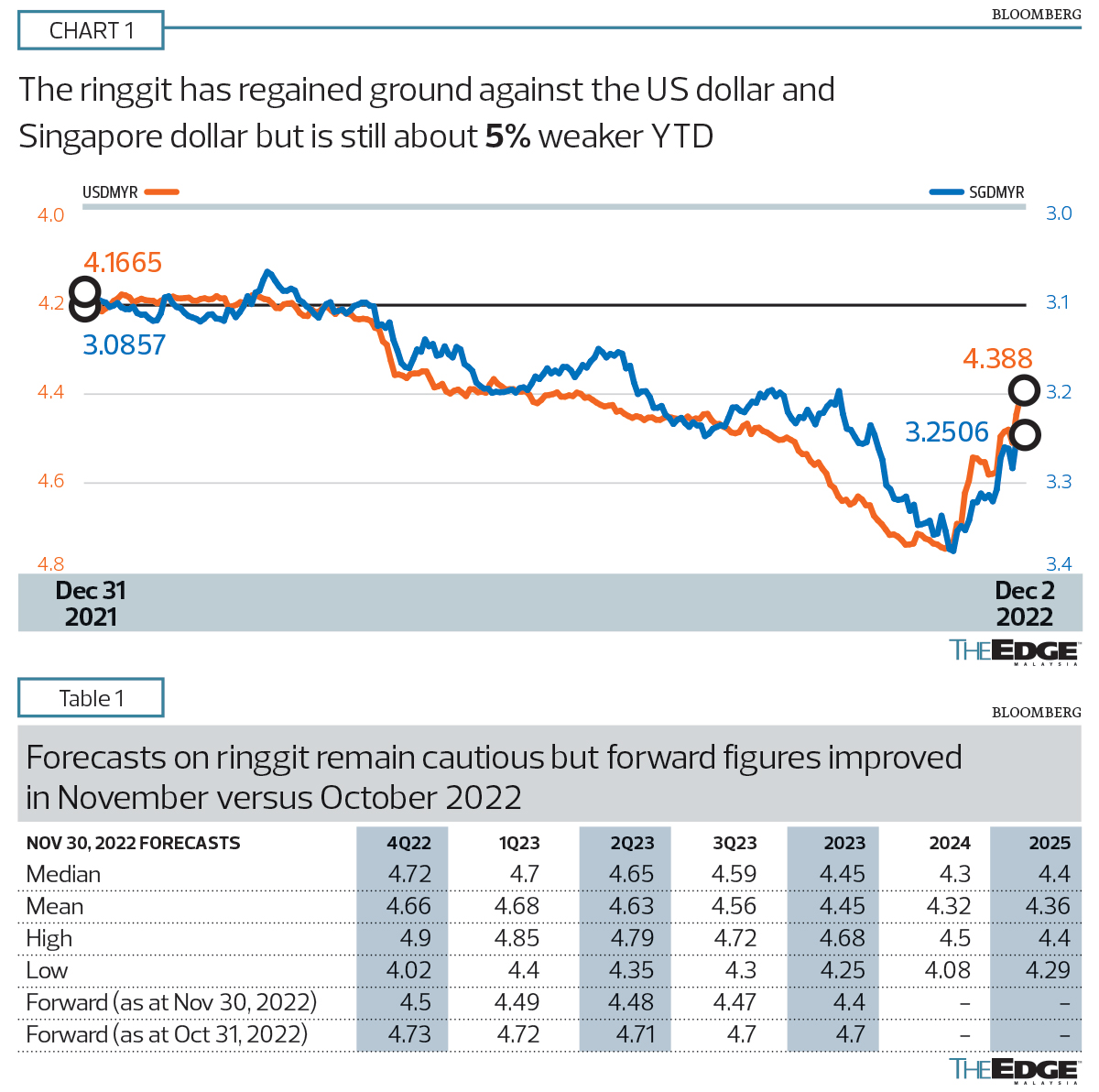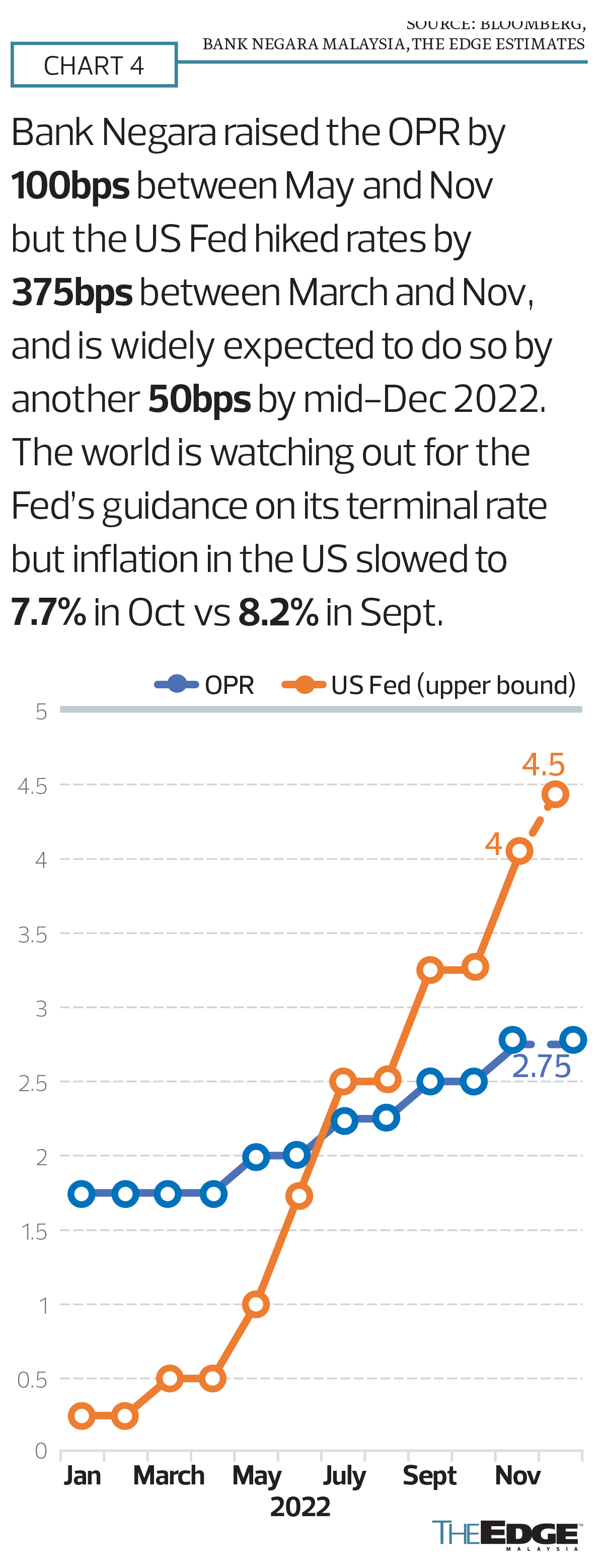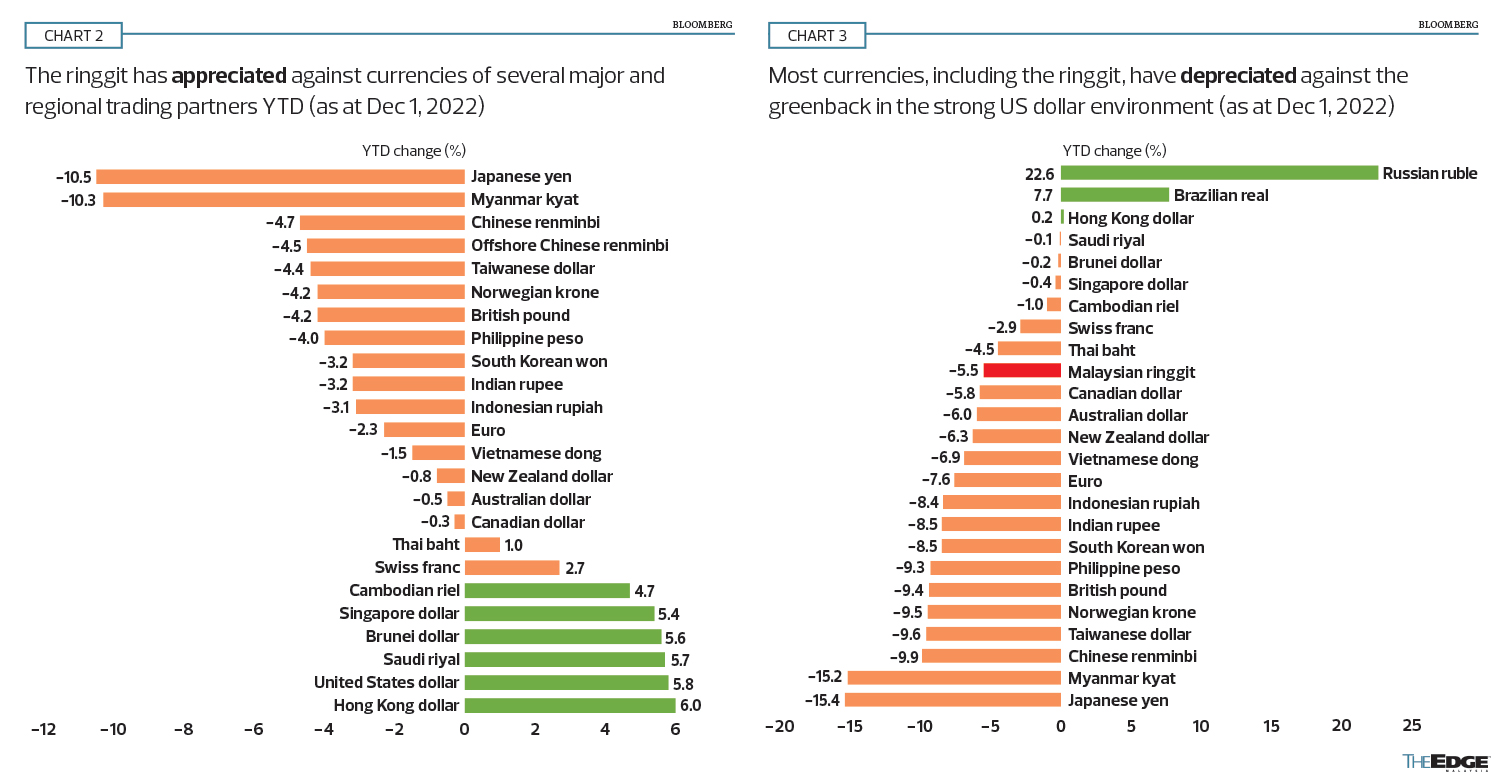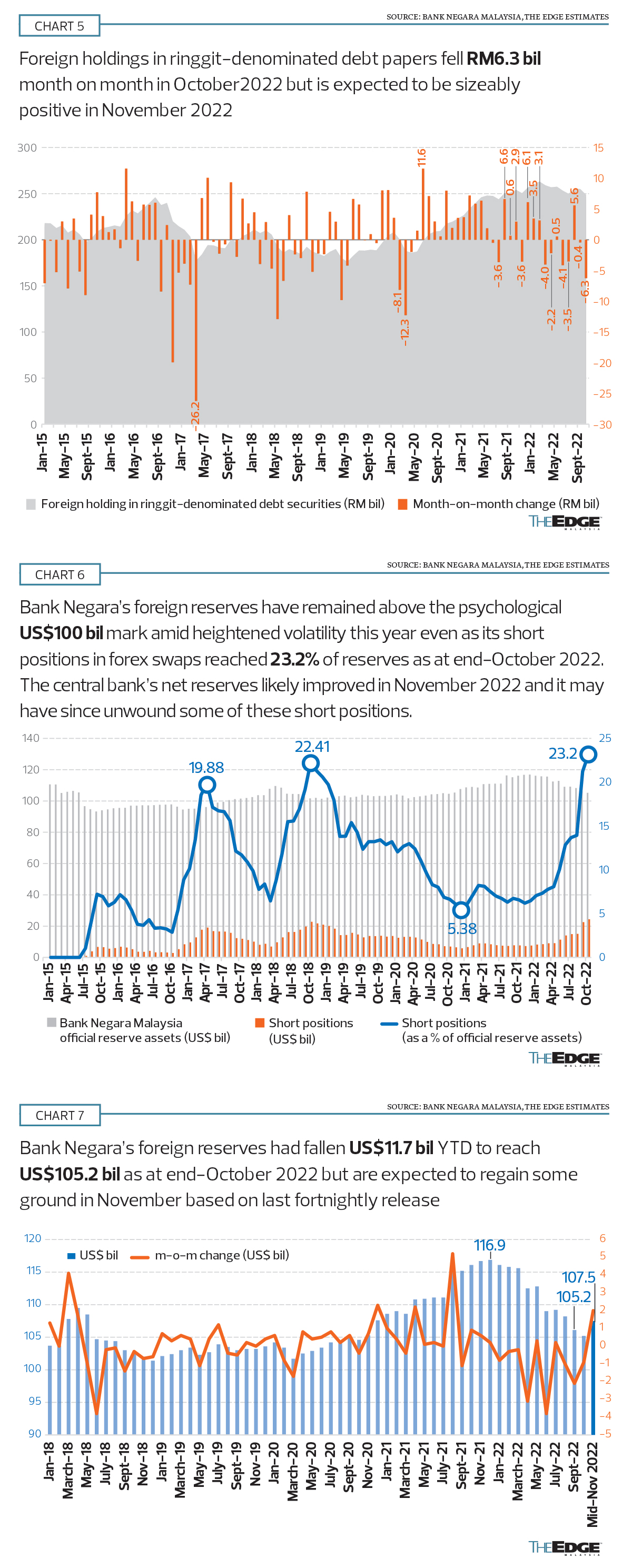
This article first appeared in The Edge Malaysia Weekly on December 5, 2022 - December 11, 2022
WHEN Malaysia’s political impasse after the 15th general election (GE15) ended with the naming of Datuk Seri Anwar Ibrahim as Malaysia’s 10th prime minister (PM10) on Nov 24, the ringgit appreciated 1.82% against the US dollar that one day — beating every other currency and precious metal in the world in terms of day-on-day gains on the spot market, including the South Korean won that came in second at 1.78%, Bloomberg data shows.
To be sure, if measured from its lowest point of 4.7447 against the greenback on Nov 4, the ringgit had already gained 3.64% against the US dollar over three weeks when it closed at 4.575 on Nov 23, ahead of the naming of PM10, following a broader US dollar easing (on smaller rate hikes by the US Federal Reserve) as well as hope of China’s zero-Covid policy coming to an end.
The ringgit’s 4.388-close against the US dollar last Friday (Dec 2) was its strongest in six months but still about 5.3% down year to date (YTD) against the greenback. The ringgit was also still about 5.3% weaker against the Singapore dollar YTD at its 3.2506-close on Dec 2, though it had clawed back 3.73% from the all-time low of 3.3764 on Nov 8. (See Chart 1.)
That said, the ringgit had appreciated against the currencies of several trading partners, including the yen, renminbi, pound sterling, Indian rupee, rupiah and the euro. (See Charts 2 and 3.)
While Bloomberg data shows forecasts on the ringgit remain cautious, data on forwards has improved as at end-November compared with where they were at end-October. (See Table 1.)
Is the worst over for the ringgit?
“We still remain cautiously optimistic for the ringgit but it will strengthen considerably only in a sustained way next year. Near term, the ringgit has seen some appreciation vis-à-vis the US dollar amid retracement in US Treasury yields, China reopening plays and expectations of a China recovery in 2023, despite a moderating China growth momentum in 2022,” says Saktiandi Supaat, Maybank Investment Banking Group regional head of foreign exchange (forex) research and strategy.
“The political uncertainty factor, which has dampened sentiment, has receded following the recent election outcome. However, for now, we still remain cautious until signs of credible policymaking direction emerge and the US dollar support softens sustainably. We think this would need at least another one to two quarters. On balance, we see a higher likelihood for the ringgit’s sustained recovery to gather traction only within 1H2023,” he adds, noting though that the ringgit “looks relatively ‘cheap’ in real effective exchange rate (REER) terms and trade balances remain benign”.
For now, Supaat sees the ringgit ending 2022 between 4.40 and 4.50 against the US dollar and between 3.20 and 3.30 against the Singapore dollar before strengthening to between 4.10 and 4.20 against the greenback and between 3.00 and 3.10 versus the Singapore dollar in 2023.
He reckons that it is “possible” for the ringgit to trade within the 4.20 to 4.30 range against the US dollar and 3.10 to 3.20 range against the Singapore dollar within the next three to six months “if the US dollar declines are exacerbated and China reopening plays intensify”.
“My view is that there is still risk that China continues to remain cautious in its reopening and the US Fed reiterating its hawkish stance again amid an uptick in inflation,” he elaborates, noting that the forex market remains “quite volatile” owing to ongoing developments at the US Fed and China.
Fed terminal rate, recession risk key
At the time of writing, the US Fed had not said what its terminal rate would be, but market forecasts point to the lower end of a 4.75% to 5.75% range — which points to another 50-basis-point hike early next year after the expected 50bp hike come Dec 14, a slower increase after four consecutive 75bp hikes and a cumulative 375bp increase since March 16 to 3.75% to 4% on Nov 2. (See Chart 4.)
Supaat expects the Fed’s terminal rate in the “5% to 5.25%” range, adding that asset prices globally would “need to move again” if the Fed’s terminal rate were as high as 5.5% to 6% as the US dollar bulls would want.
“The strength of the US dollar that had dominated for much of this year could be chipped away gradually into 2023 as the Fed slows its pace of tightening and eventually stops. But US dollar bulls will not give up fully without a fight. So, we may still see some choppy moves in the US dollar, but USD strength and support will not be as strong as what we see in 2022,” he says, noting, though, that the greenback may continue to count on safe-haven demand given that geopolitical conflicts (war in Ukraine, tensions over Taiwan) are unlikely to fade completely.
That means a higher Fed guidance on the terminal rate and a world going into a sharper recession could see stronger dollar support than if the world were to go through a mild recession, if any, on the back of a lower terminal rate and weaker US dollar environment.
“Fundamentally, we are negatively biased towards the US dollar in the medium term, given the country’s twin deficits, and the national debt is also expected to rise further over the next few years. However, the risk-reward ratio does not favour outright US dollar bets for most of 2023 and conviction for US dollar bears may only gain more traction as we proceed further in 2023,” Supaat adds.
Winson Phoon, head of fixed income research at Maybank in Singapore, also expects the Fed’s terminal rate to be “slightly over 5%”, which he says the market has “priced in”. “A 6% Fed funds rate would be a shock outcome and very detrimental to global asset prices and regional foreign exchange, not where we would expect it to reach”.
“We are cautiously optimistic on foreign demand for ringgit bonds over the next six to 12 months on the assumption that the Fed will not only pause but start cutting rates in the latter part of 2023,” Phoon says.
Healthy demand for ringgit bonds
Asked if the foreign selling of Malaysian Government Securities (MGS) had abated in November, even as the ringgit regained some strength, after Bank Negara Malaysia data showed foreign holding in ringgit-denominated debt paper had fallen RM6.3 billion month on month in October — its steepest since March 2020 (see Chart 5), Phoon had this to say: “We believe the foreign holdings of MGS had rebounded strongly in November, perhaps to the tune of RM5 billion or larger following a sizeable drawdown in October. Bond inflows and ringgit strength can be a reinforcing factor to each other, [meaning] expectation of a stronger ringgit drives inflows which, in turn, extends the strength of the currency, and vice versa.”
Phoon would not sound the alarm bell just yet, although data shows Bank Negara’s forward liabilities have increased substantially this year to US$24.4 billion as at end-October or 23.2% of the central bank’s reserves (see Chart 6). These forward liabilities put Bank Negara’s net reserves at US$80.9 billion, which back-of-the-envelope calculations show to be about 0.8 times short-term external reserves and four times imports of goods and services.
“The higher net short in Bank Negara’s forex forward book was likely a result of increased foreign exchange intervention, especially in September, amid heightened market volatilities. Despite lower net foreign reserves, we think Bank Negara still possesses sufficient capacity for market intervention. Given a much stronger ringgit in November, Bank Negara might have taken the opportunity to pare down its forex forward net short and rebuild some buffers,” Phoon says.
For the record, the 23.2% is higher than the 22.41% of reserves reached in October 2018 when short positions were US$22.8 billion while Bank Negara’s reserves stood at US$101.7 billion. Back then, Bank Negara saw its reserves fall US$7.4 billion between May and December 2018 before stabilising.
Between August and October this year, Bank Negara saw its reserves fall by US$3 billion to end-October at US$105.2 billion. Nonetheless, Bank Negara’s reserves gained US$2.3 billion in the first two weeks of November with reserves at US$107.5 billion as at Nov 15, 2022, being enough to cover one time short-term external debt and 5.2 months of imports of goods and services (6.2 months on the old measure). (See Chart 7.)
“The demand for ringgit government bonds should remain healthy, primarily driven by major domestic investors [such as] pension funds and banks. An improvement in bond returns and growing recession risk could also drive some inflows to bond funds. We are cautiously optimistic on foreign demand, although the flows can be choppy and inconsistent,” says Phoon, who forecast higher gross MGS+GII issuance of RM175 billion in 2023 by the federal government but unchanged in net issuance at RM97 billion.
Fleeting as it may be, the ringgit’s one-day winning spurt on Nov 24 showed how certainty matters. Certainty is still lacking in a number of areas, including fiscal and macro policy direction and in what form Budget 2023 would be re-tabled. As it is, what’s certain is the size of debt the Anwar administration inherits, and improving the country’s fiscal standing would require tough and unpopular decisions.
Save by subscribing to us for your print and/or digital copy.
P/S: The Edge is also available on Apple's App Store and Android's Google Play.
- Trump's big blunder — and no, it's not tariff per se
- Gamuda, IJM, MRCB, SunCon could bid for Penang International Airport's main terminal building under Package 3 in May, estimated at RM1.2b — CIMB
- AmBank grants RM307m in financing to Chin Hin Group for infrastructure projects
- Intel CEO invested in hundreds of Chinese companies, some with military ties
- Umno wants transfer of Seri Pacific hotel land held under trusteeship of Dr M, Daim, two others
- Zelenskiy accuses Russia of systematically recruiting Chinese fighters
- Goldman cuts US auto sales estimate by nearly one million units due to tariffs
- German economy to stagnate even if Trump scraps 'reciprocal' tariffs, say forecasters
- Chin Hin, HeiTech Padu, MyEG, MSM, Ranhill, Toyo Ventures, YNH Property
- Safe-haven gold shines as US-China trade war intensifies, dollar weakens




